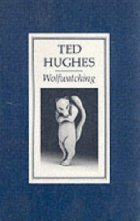‘Wolfwatching’ by Ted Hughes
 If you were to ask me to name my favourite poet, I would have a very hard time naming just one, as I read different people for different things. I read Robert Browning for his amazing dramatic monologues; John Donne for his fiery passion, whether holy or secular; W. B. Yeats for his mysticism and occultism; Shakespeare for wit and brilliance; Hillaire Belloc, Edward Lear and Lewis Carroll for their humour; and there are a host of others I can turn to in any given mood. Ted Hughes, I read primarily for his nature poetry which illuminates creatures and landscapes that I see all the time with a clarity and accuracy which make me see them in a new way.
If you were to ask me to name my favourite poet, I would have a very hard time naming just one, as I read different people for different things. I read Robert Browning for his amazing dramatic monologues; John Donne for his fiery passion, whether holy or secular; W. B. Yeats for his mysticism and occultism; Shakespeare for wit and brilliance; Hillaire Belloc, Edward Lear and Lewis Carroll for their humour; and there are a host of others I can turn to in any given mood. Ted Hughes, I read primarily for his nature poetry which illuminates creatures and landscapes that I see all the time with a clarity and accuracy which make me see them in a new way.
Wolfwatching is a collection of poems which divides fairly evenly into the nature poems that I love so much and poems about Hughes’ father and their relationship. I personally prefer the former type because of the shocks of recognition that they provide; the poems which aren’t centred around the natural world are more opaque and harder to pin down, but they feel profound even if I don’t understand them as well. It is a slim volume of only 55 pages, but it is powerfully written and full of beautiful phrases.
As I find it almost impossible to review poetry, I thought I would share some of my favourite passages instead. The first example is drawn from the first poem in the book, ‘A Sparrow Hawk’:
Those eyes in their helmet
Still wired direct
To the nuclear core – they alone
Laser the lark-shaped hole
In the lark’s song.
I love how it both physically describes the bird and conveys the speed, efficiency and deadliness of the hawk’s attack.
Next is an offering from ‘Manchester Skytrain’, perfectly describing a highly-strung racehorse:
Every known musical instrument
The whole ensemble, packed
Into a top-heavy, twangling half ton
On the stilts of an insect.
And finally, the famous ending of one of the more esoteric poems in the collection, ‘Two Astrological Conundrums II: Tell’:
With all my might – I hesitated.
Wolfwatching by Ted Hughes. Published by Faber and Faber, 1989, pp. 55. First edition.